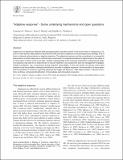Files in this item
"Adaptive response" - some underlying mechanisms and open questions
Item metadata
| dc.contributor.author | Dimova, Evgeniya G | |
| dc.contributor.author | Bryant, Peter Edward | |
| dc.contributor.author | Chankova, Stephka G | |
| dc.date.accessioned | 2013-01-10T12:01:01Z | |
| dc.date.available | 2013-01-10T12:01:01Z | |
| dc.date.issued | 2008 | |
| dc.identifier | 403912 | |
| dc.identifier | 08c6d9b3-fbe9-42e3-b41c-ad9cbfaf0f83 | |
| dc.identifier | 000256957500002 | |
| dc.identifier | 46649112964 | |
| dc.identifier.citation | Dimova , E G , Bryant , P E & Chankova , S G 2008 , ' "Adaptive response" - some underlying mechanisms and open questions ' , Genetics and Molecular Biology , vol. 31 , no. 2 , pp. 396-408 . https://doi.org/10.1590/S1415-47572008000300002 | en |
| dc.identifier.issn | 1415-4757 | |
| dc.identifier.uri | https://hdl.handle.net/10023/3327 | |
| dc.description.abstract | Organisms are affected by different DNA damaging agents naturally present in the environment or released as a result of human activity. Many defense mechanisms have evolved in organisms to minimize genotoxic damage. One of them is induced radioresistance or adaptive response. The adaptive response could be considered as a nonspecific phenomenon in which exposure to minimal stress could result in increased resistance to higher levels of the same or to other types of stress some hours later. A better understanding of the molecular mechanism underlying the adaptive response may lead to an improvement of cancer treatment, risk assessment and risk management strategies, radiation protection, e. g. of astronauts during long-term space flights. In this mini-review we discuss some open questions and the probable underlying mechanisms involved in adaptive response: the transcription of many genes and the activation of numerous signaling pathways that trigger cell defenses - DNA repair systems, induction of proteins synthesis, enhanced detoxification of free radicals and antioxidant production. | |
| dc.format.extent | 13 | |
| dc.format.extent | 268107 | |
| dc.language.iso | eng | |
| dc.relation.ispartof | Genetics and Molecular Biology | en |
| dc.subject | Adaptive response | en |
| dc.subject | Oxidative stress | en |
| dc.subject | DNA repair up-regulation | en |
| dc.subject | DNA-binding proteins | en |
| dc.subject | Antioxidant defense system | en |
| dc.subject | Low-dose radiation | en |
| dc.subject | Peripheral-blood lympPEROXIDE INDUCES PROTECTIONhocytes | en |
| dc.subject | Peroxide induces protection | en |
| dc.subject | Methyl mercuric-chloride | en |
| dc.subject | Double-strand breaks | en |
| dc.subject | Nuclear-power-plant | en |
| dc.subject | Induced DNA-damage | en |
| dc.subject | Hamster V79 cells | en |
| dc.subject | Ionizing-radiation | en |
| dc.subject | Chlamydomonas-reinhardtii | en |
| dc.subject | QH426 Genetics | en |
| dc.subject | SDG 3 - Good Health and Well-being | en |
| dc.subject.lcc | QH426 | en |
| dc.title | "Adaptive response" - some underlying mechanisms and open questions | en |
| dc.type | Journal article | en |
| dc.contributor.institution | University of St Andrews. School of Medicine | en |
| dc.identifier.doi | https://doi.org/10.1590/S1415-47572008000300002 | |
| dc.description.status | Peer reviewed | en |
| dc.identifier.url | http://www.scopus.com/inward/record.url?scp=46649112964&partnerID=8YFLogxK | en |
This item appears in the following Collection(s)
Items in the St Andrews Research Repository are protected by copyright, with all rights reserved, unless otherwise indicated.

